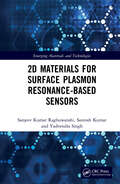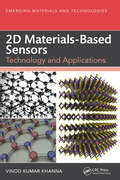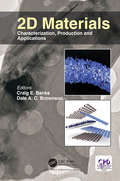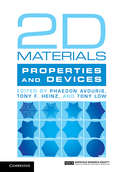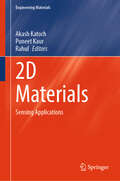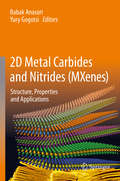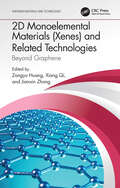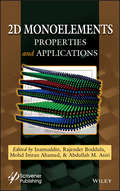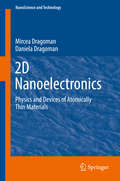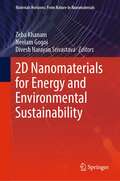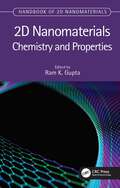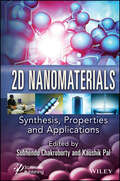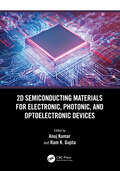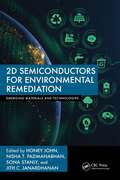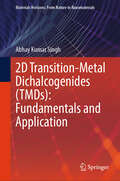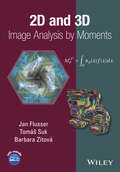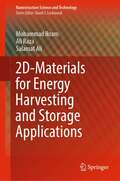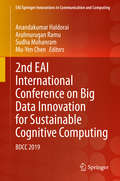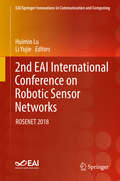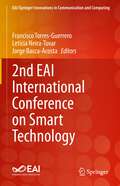- Table View
- List View
2D Materials for Surface Plasmon Resonance-based Sensors (Emerging Materials and Technologies)
by Santosh Kumar Sanjeev Kumar Raghuwanshi Yadvendra Singh2D Materials for Surface Plasmon Resonance-based Sensors offers comprehensive coverage of recent design and development (including processing and fabrication) of 2D materials in the context of plasmonic-based devices. It provides a thorough overview of the basic principles and techniques used in the analysis and design of 2D material-based optical sensor systems. Beginning with the basic concepts of plasmon/plasmonic sensors and mathematical modelling, the authors explain the fundamental properties of 2D materials, including Black Phosphorus (BP), Phosphorene, Graphene, Transition metal dichalcogenides (TMDCs), MXene's and SW-CNT. It also details the applications of these emerging materials in clinical diagnosis and their future trends. This text will be useful for practising engineers, undergraduate and postgraduate students. Key Features Presents the fundamental concepts of 2D material assisted fibre optic and prism based SPR sensor in a student-friendly manner. Includes the recent synthesis and characterization techniques of 2D materials. Provides computational results of recently discovered electronic and optical properties of the 2D materials along with their effectiveness in the field of plasmonic sensors. Presents emerging applications of novel 2D material-based plasmonic sensors in the field of chemical, bio-chemical and biosensing.
2D Materials-Based Sensors: Technology and Applications (Emerging Materials and Technologies)
by Vinod Kumar Khanna2D Materials-Based Sensors: Technology and Applications is a comprehensive book covering the latest innovations on sensors using the unique properties of 2D materials. This specialized text: Key Features Describes 2D materials process technology and integration of these materials into sensor fabrication. Provides an in-depth coverage of the underlying physics, operation, and performance metrics of 2D materials-based sensors. Highlights state-of-the-art developments in 2D material sensors vis-à-vis challenges faced in their fabrication. Presents glimpses of emerging 2D materials-based sensor technologies that will shape the future. Expedites understanding and learning through plain, lucid explanations, and clear, insightful diagrams. Commencing from an introductory survey of the 2D materials family, the book describes their impressive properties and their top-down and bottom-up synthesis techniques. The succeeding chapters present detailed descriptions of 2D materials-based mechanical sensors, photodetectors, magnetic sensors together with quantum sensors, heavy-metal ion sensors, gas sensors, and biological sensors. The book concludes with the research challenges, emerging trends, and limitations providing a balanced perspective of this fast-progressing field. This book is a concise guide for students, scientists, and technologists engaged in sensor research and development.
2D Materials: Characterization, Production and Applications
by Craig E. Banks Dale A. BrownsonMost reference texts covering two-dimensional materials focus specifically on graphene, when in reality, there are a host of new two-dimensional materials poised to overtake graphene. This book provides an authoritative source of information on twodimensional materials covering a plethora of fields and subjects and outlining all two-dimensional materials in terms of their fundamental understanding, synthesis, and applications.
2D Materials: Properties and Devices
by Heinz Phaedon Avouris Tony F. Tony LowLearn about the most recent advances in 2D materials with this comprehensive and accessible text. Providing all the necessary materials science and physics background, leading experts discuss the fundamental properties of a wide range of 2D materials, and their potential applications in electronic, optoelectronic and photonic devices. Several important classes of materials are covered, from more established ones such as graphene, hexagonal boron nitride, and transition metal dichalcogenides, to new and emerging materials such as black phosphorus, silicene, and germanene. Readers will gain an in-depth understanding of the electronic structure and optical, thermal, mechanical, vibrational, spin and plasmonic properties of each material, as well as the different techniques that can be used for their synthesis. Presenting a unified perspective on 2D materials, this is an excellent resource for graduate students, researchers and practitioners working in nanotechnology, nanoelectronics, nanophotonics, condensed matter physics, and chemistry.
2D Materials: Sensing Applications (Engineering Materials)
by Akash Katoch Puneet Kaur RahulThis book summarizes various scalable and cost-effective techniques to fabricate different 2D materials beyond graphene including, but not limited to, transition metal dichalcognides (TMDs), MXenes, Transition Metal Oxides (TMOs), etc. This book focuses on recent advancements in the field of sensors based on these 2D materials and their heterostructures. These materials exhibit a wide range of sensing applications and have become one of the potential research areas for the scientific community due to their exceptional and tunable properties. This book provides basic and fundamental knowledge about various sensing mechanisms, challenges, and future opportunities for the fabrication/development of the next-generation sensors with applications in daily lives.
2D Metal Carbides and Nitrides (MXenes): Structure, Properties and Applications
by Yury Gogotsi Babak AnasoriThis book describes the rapidly expanding field of two-dimensional (2D) transition metal carbides and nitrides (MXenes). It covers fundamental knowledge on synthesis, structure, and properties of these new materials, and a description of their processing, scale-up and emerging applications. The ways in which the quickly expanding family of MXenes can outperform other novel nanomaterials in a variety of applications, spanning from energy storage and conversion to electronics; from water science to transportation; and in defense and medical applications, are discussed in detail.
2D Monoelemental Materials: Beyond Graphene (Emerging Materials and Technologies)
by Zongyu Huang, Xiang Qi, and Jianxin ZhongMonoelemental 2D materials called Xenes have a graphene-like structure, intra-layer covalent bond, and weak van der Waals forces between layers. Materials composed of different groups of elements have different structures and rich properties, making Xenes materials a potential candidate for the next generation of 2D materials. 2D Monoelemental Materials (Xenes) and Related Technologies: Beyond Graphene describes the structure, properties, and applications of Xenes by classification and section. The first section covers the structure and classification of single-element 2D materials, according to the different main groups of monoelemental materials of different components and includes the properties and applications with detailed description. The second section discusses the structure, properties, and applications of advanced 2D Xenes materials, which are composed of heterogeneous structures, produced by defects, and regulated by the field. Features include: Systematically detailed single element materials according to the main groups of the constituent elements Classification of the most effective and widely studied 2D Xenes materials Expounding upon changes in properties and improvements in applications by different regulation mechanisms Discussion of the significance of 2D single-element materials where structural characteristics are closely combined with different preparation methods and the relevant theoretical properties complement each other with practical applications Aimed at researchers and advanced students in materials science and engineering, this book offers a broad view of current knowledge in the emerging and promising field of 2D monoelemental materials.
2D Monoelements: Properties and Applications
by Abdullah M. Asiri Mohd Imran Ahamed Rajender Boddula Inamuddin2D Monoelements: Properties and Applications explores the challenges, research progress and future developments of the basic idea of two-dimensional monoelements, classifications, and application in field-effect transistors for sensing and biosensing. The thematic topics include investigations such as: Recent advances in phosphorene The diverse properties of two-dimensional antimonene, of graphene and its derivatives The molecular docking simulation study used to analyze the binding mechanisms of graphene oxide as a cancer drug carrier Metal-organic frameworks (MOFs)-derived carbon (graphene and carbon nanotubes) and MOF-carbon composite materials, with a special emphasis on the use of these nanostructures for energy storage devices (supercapacitors) Two-dimensional monoelements classification like graphene application in field-effect transistors for sensing and biosensing Graphene-based ternary materials as a supercapacitor electrode Rise of silicene and its applications in gas sensing
2D Nanoelectronics: Physics and Devices of Atomically Thin Materials (NanoScience and Technology)
by Mircea Dragoman Daniela DragomanThis book is dedicated to the new two-dimensional one-atomic-layer-thick materials such as graphene, metallic chalcogenides, silicene and other 2D materials. The book describes their main physical properties and applications in nanoelctronics, photonics, sensing and computing. A large part of the book deals with graphene and its amazing physical properties. Another important part of the book deals with semiconductor monolayers such as MoS2 with impressive applications in photonics, and electronics. Silicene and germanene are the atom-thick counterparts of silicon and germanium with impressive applications in electronics and photonics which are still unexplored. Consideration of two-dimensional electron gas devices conclude the treatment. The physics of 2DEG is explained in detail and the applications in THz and IR region are discussed. Both authors are working currently on these 2D materials developing theory and applications.
2D Nanomaterials for Energy and Environmental Sustainability (Materials Horizons: From Nature to Nanomaterials)
by Zeba Khanam Neelam Gogoi Divesh Narayan SrivastavaThis book presents cutting-edge research, recent breakthroughs, and unresolved challenges associated with 2D nanomaterials to combat energy and environmental issues. The book discusses the state-of-the-art design and innovations engaged to novel 2D nanomaterials, viz. Transition metal compounds (TMDs, TMOs, TMHs), MXenes, elemental 2D analogs (silicene, phosphorene, arsenene, etc.), Metal-organic frameworks (MOFs), etc. It presents the latest trends on top-down and bottom-up synthesis approaches and properties followed by the critical status and progress of these 2D nanomaterials in the field of energy and environment. The topics cover wide spectrum of 2D nanomaterials applications including energy storage/conversion, air/water/soil remediation, adsorption, photocatalytic degradation, desalination and membrane filtration, detection and sensing, drug delivery systems, and nano-encapsulated agro-formulations. The subsequent section includes a comprehensive account on the safety risk assessment of 2D nanomaterials towards the ecosystem and human health. This book will be beneficial for beginners, researchers, and professionals from diverse fields interested in 2D nanomaterials for energy and environmental sustainability.
2D Nanomaterials: Chemistry and Properties
by Ram K. Gupta2D nanomaterials have emerged as promising candidates for use in energy devices owing to their superior electrochemical properties, surface area, nanodevice integration, multifunctionality, printability, and mechanical flexibility. 2D Nanomaterials: Chemistry and Properties covers basic concepts, chemistries, and properties along with theoretical considerations in designing new 2D nanomaterials, especially for energy applications. This book: Discusses the effect of doping, structural variation, phase, and exfoliation on structural and electrochemical properties of 2D nanomaterials Presents synthesis, characterization, and applications of 2D materials for green energy production and storage Explores new aspects of synthesizing 2D nanomaterials beyond traditionally layered structures Examines challenges in using 2D materials for energy applications This book is aimed at materials scientists, chemists, electrochemists, and engineers working in energy disciplines.
2D Nanomaterials: Synthesis, Properties, and Applications
by Kaushik Pal Subhendu Chakroborty2D NANOMATERIALS The book provides a comprehensive overview of the synthesis, modification, characterization, and application of 2D nanomaterials. In recent years, 2D nanomaterials have emerged as a remarkable cornerstone in the field of advanced materials research, with their unique properties and versatile applications captivating the attention of scientists and engineers worldwide. This book is a testament to the ever-growing interest and importance of 2D nanomaterials in the realm of materials science, nanotechnology, pharmaceuticals, and a myriad of engineering specializations. The book is structured into three sections, each delving into different aspects of 2D nanomaterials. The first section explores the synthesis of these materials, providing an overview of both top-down and bottom-up strategies. Understanding the methods by which these materials can be synthesized is crucial for advancing their potential applications. Additionally, this section details the structural characterization of 2D nanomaterials, shedding light on their intricate compositions and properties. The second section examines the diverse characteristics exhibited by 2D nanomaterials. From their magnetic and mechanical properties to their electrical, plasmonic, and optical behaviors, these materials possess an array of intriguing attributes that make them highly attractive for a wide range of applications. This section of the book provides a comprehensive understanding of these properties, enabling readers to appreciate the unique potential of 2D nanomaterials. The final section focuses on the applications of 2D nanomaterials, highlighting their use in various fields such as energy, water purification, biomedical applications, multimodal tumor therapy, and supercapacitor technology.
2D Semiconducting Materials for Electronic, Photonic, and Optoelectronic Devices
by Anuj Kumar Ram K. GuptaTwo-dimensional semiconducting materials (2D-SCMs) are the subject of intensive study in the fields of photonics and optoelectronics because of their unusual optical, electrical, thermal, and mechanical properties. The main objective of 2D Semiconducting Materials for Electronic, Photonic, and Optoelectronic Devices is to provide current, state-of-the-art knowledge of two-dimensional semiconducting materials for various applications. Two-dimensional semiconducting materials are the basic building blocks for making photodiodes, light-emitting diodes, light-detecting devices, data storage, telecommunications, and energy-storage devices. When it comes to two-dimensional semiconducting materials, electronic, photonic, and optoelectronic applications, as well as future plans for improving performance, no modern book covers as much ground. The planned book will fill such gaps by offering a comprehensive analysis of two-dimensional semiconducting materials. This book covers a range of advanced 2D materials, their fundamentals, and the chemistry for many emerging applications. All the chapters are covered by experts in these areas around the world, making this a suitable textbook for students and providing new guidelines to researchers and industries. • Covers topics such as fundamentals and advanced knowledge of two-dimensional semiconducting materials • Provides details about the recent methods used for the synthesis, characterization, and applications of two-dimensional semiconducting materials • Covers the state-of-the-art development in two-dimensional semiconducting materials and their emerging applications This book provides directions to students, scientists, and researchers in semiconductors and related disciplines to help them better understand the physics, characteristics, and applications of 2D semiconductors.
2D Semiconductors for Environmental Remediation (Emerging Materials and Technologies)
by Honey John Nisha T. Padmanabhan Sona Stanly Jith C. JanardhananThis book gives a comprehensive description of various aspects of 2D semiconductors including their synthesis, surface science, characterizations, and their allied application in environmental remediation including air and water purification, oil-water separation, hydrogen production, and CO2 removal. The electronic and optoelectronic enhancement properties of these semiconductors with bandgap engineering, doping, and chemical functionalization for various applications are exemplified.Features: Provides focus on the application of 2D semiconductors for environmental applications. Covers the fundamental understanding of material design, fabrication, defect engineering, physical and chemical properties of 2D semiconductors, and their advantages for environmental applications. Focuses on the reliable future perspectives and developments that lead to advanced research in utilizing 2D materials for large-scale exploration and commercial deployment. Explores an in-depth insight into various aspects and processes for environmental remediation. Details the importance of 2D semiconductors over other 0D, 1D, or 3D semiconductors. This book is aimed at researchers and graduate students in materials science and environmental engineering.
2D Transition-Metal Dichalcogenides (Materials Horizons: From Nature to Nanomaterials)
by Abhay Kumar SinghThis book offers to reader a sound understating of two-dimensional Transition-Metal Dichalcogenides (2D TMDs) materials, detailing their physio-chemical mechanisms and technological applications in various areas such as nanoelectronics and optoelectronics. Moving from their invention to their modern developments, including theoretical approaches, experimental interpretations and their technical applications, the book explores the basic concepts of 2D TMDs. It will be of interest to undergraduate and postgraduate students, researchers and scientists working in the area of 2D TMDs. A key goal of this book provides a sound or clear idea about two-dimensional Transition-Metal Dichalcogenides (2D TMDs) materials by providing their sound background, fabrication approaches including interpretations of the inside physio-chemical mechanism including technological applications in various significant areas such as nanoelectronics, optoelectronics, topological insulators, biomedical.
2D and 3D Image Analysis by Moments
by Barbara Zitova Jan Flusser Tomas SukPresents recent significant and rapid development in the field of 2D and 3D image analysis 2D and 3D Image Analysis by Moments, is a unique compendium of moment-based image analysis which includes traditional methods and also reflects the latest development of the field. The book presents a survey of 2D and 3D moment invariants with respect to similarity and affine spatial transformations and to image blurring and smoothing by various filters. The book comprehensively describes the mathematical background and theorems about the invariants but a large part is also devoted to practical usage of moments. Applications from various fields of computer vision, remote sensing, medical imaging, image retrieval, watermarking, and forensic analysis are demonstrated. Attention is also paid to efficient algorithms of moment computation. Key features: Presents a systematic overview of moment-based features used in 2D and 3D image analysis. Demonstrates invariant properties of moments with respect to various spatial and intensity transformations. Reviews and compares several orthogonal polynomials and respective moments. Describes efficient numerical algorithms for moment computation. It is a "classroom ready" textbook with a self-contained introduction to classifier design. The accompanying website contains around 300 lecture slides, Matlab codes, complete lists of the invariants, test images, and other supplementary material. 2D and 3D Image Analysis by Moments, is ideal for mathematicians, computer scientists, engineers, software developers, and Ph.D students involved in image analysis and recognition. Due to the addition of two introductory chapters on classifier design, the book may also serve as a self-contained textbook for graduate university courses on object recognition.
2D-Materials for Energy Harvesting and Storage Applications (Nanostructure Science and Technology)
by Ali Raza Muhammad Ikram Salamat AliThis authored monograph presents the state-of-the-art improvements in 2D materials, focusing on their most significant achievements, as well as recent emergence and potential applications. The book discusses synthetic protocols as well as the structural chemistry and physical properties of various 2D materials and explores their energy-related utilization. The main energy harvesting applications such as piezoelectric generators, solar cells and hydrogen evolution reactions are analyzed, while special focus is also given to the related energy storage technologies such as rechargeable batteries, supercapacitors and wearable energy storage devices. This volume sheds new light on 2D materials and their applications and will be a useful tool for graduates and academics working in the fields of materials science, materials physics and chemistry.
2nd EAI International Conference on Big Data Innovation for Sustainable Cognitive Computing: BDCC 2019 (EAI/Springer Innovations in Communication and Computing)
by Anandakumar Haldorai Arulmurugan Ramu Sudha Mohanram Mu-Yen ChenThis proceeding features papers discussing big data innovation for sustainable cognitive computing. The papers feature details on cognitive computing and its self-learning systems that use data mining, pattern recognition and natural language processing (NLP) to mirror the way the human brain works. This international conference focuses on cognitive computing technologies, from knowledge representation techniques and natural language processing algorithms to dynamic learning approaches. Topics covered include Data Science for Cognitive Analysis, Real-Time Ubiquitous Data Science, Platform for Privacy Preserving Data Science, and Internet-Based Cognitive Platform. The 2nd EAI International Conference on Big Data Innovation for Sustainable Cognitive Computing (BDCC 2019) took place in Coimbatore, India on December 12-13, 2019.Contains proceedings from 2nd EAI International Conference on Big Data Innovation for Sustainable Cognitive Computing (BDCC 2019), Coimbatore, India, December 12-13, 2019;Features topics ranging from Data Science for Cognitive Analysis to Internet-Based Cognitive Platforms;Includes contributions from researchers, academics, and professionals from around the world.
2nd EAI International Conference on Robotic Sensor Networks: ROSENET 2018 (EAI/Springer Innovations in Communication and Computing)
by Huimin Lu Li YujieThis book provides scientific research into Cognitive Internet of Things for Smart Society, with papers presented at the 2nd EAI International Conference on Robotic Sensor Networks. The conference explores the integration of networks and robotic technologies, which has become a topic of increasing interest for both researchers and developers from academic fields and industries worldwide. The authors posit that big networks will be the main approach to the next generation of robotic research, with the explosive number of networks models and increasing computational power of computers significantly extending the number of potential applications for robotic technologies while also bringing new challenges to the network's community. The 2nd EAI International Conference on Robotic Sensor Networks was held 25-26 August 2018 at the Kitakyushu International Conference Center (MICE), Kitakyushu, Japan.
2nd EAI International Conference on Smart Technology (EAI/Springer Innovations in Communication and Computing)
by Leticia Neira-Tovar Francisco Torres-Guerrero Jorge Bacca-AcostaThis book presents the proceedings of 2nd EAI International Conference on Smart Technology (MTYMEX), which took place April 27th, 2021, online and in Monterrey, Mexico. MTYMEX is an international conference aimed at demonstrating the potential of new applications for the Internet in the future. The authors offer perspectives on research on smart technologies in society, including the results of research projects on virtual reality, blockchain, artificial intelligence, and smart cities. The book offers examples of applications with smart technologies in different knowledge areas. The conference brings together the academic, research and private sectors working on applications and smart devices for e-health and smart cities.
2nd IMA Conference on Mathematics of Robotics (Springer Proceedings in Advanced Robotics #21)
by William Holderbaum J. M. SeligThis book highlights the mathematical depth and sophistication of techniques used in different areas of robotics. Each chapter is a peer-reviewed version of a paper presented during the 2021 IMA Conference on the Mathematics of Robotics, held online September 8–10, 2021. The conference gave a platform to researchers with fundamental contributions and for academic and to share new ideas. The book illustrates some of the current interest in advanced mathematics and robotics such as algebraic geometry, tropical geometry, monodromy and homotopy continuation methods applied to areas such as kinematics, path planning, swam robotics, dynamics and control. It is hoped that the conference and this publications will stimulate further related mathematical research in robotics.
2nd International Conference for Innovation in Biomedical Engineering and Life Sciences: ICIBEL 2017 (in conjunction with APCMBE 2017),10 - 13 December 2017, Penang, Malaysia (IFMBE Proceedings #67)
by Fatimah Ibrahim Juliana Usman Mohd Yazed Ahmad Norhamizan Hamzah Swe Jyan TehThis volume presents the proceedings of ICIBEL 2017, organized by the Centre for Innovation in Medical Engineering (CIME) under Innovative Technology Research Cluster, University of Malaya. It was held in George Town, Penang, Malaysia, from 10-13 December 2017. The ICIBEL 2017 conference promotes the latest research and developments related to the integration of the Engineering technology in medical fields and life sciences. This includes the latest innovations, research trends and concerns, challenges and adopted solution in the field of medical engineering and life sciences.
2nd International Conference on 5G for Ubiquitous Connectivity: 5GU 2018 (EAI/Springer Innovations in Communication and Computing)
by Weihua Zhuang Song Guo Baoliu YeThe book presents the proceedings of the 2nd International Conference on 5G for Ubiquitous Connectivity (5GU 2018), which took place on December 4-5, 2018 in Nanjing, People’s Republic of China. The aim of this conference is to bring together researchers and developers as well as regulators and policy makers to present their latest views on 5G, including new networking, new wireless communications, resource control & management, future access techniques, new emerging applications, and latest findings in key research activities on 5G. The book is applicable to researchers, academics, students, and professionals.Features practical, tested applications in 5G for ubiquitous connectivity;Includes discussion of 5G for ubiquitous connectivity in relation to wireless communications, resource control & management, and future access techniques;Applicable to researchers, academics, students, and professionals.
2nd International Conference on Advanced Joining Processes: Selected Contributions of AJP 2021 (Proceedings in Engineering Mechanics)
by Lucas F. M. da Silva Paulo A. F. Martins Uwe ReisgenThis book focusses on all advanced methods of joining such as friction stir welding, joining by plastic deformation, laser welding, advanced mechanical joining, adhesive bonding and hybrid joining. The volume presents the state-of-the-art of advanced methods of joining and also serves as a reference for researchers and graduate students working in this field.This book gathers selected contributions of the 2nd International Conference on Advanced Joining Processes 2021, held in Sintra, Portugal, on October 21–22, 2021.
2nd International Conference on Cloud Computing and Computer Networks: CCCN 2024 (Signals and Communication Technology)
by Lei MengThe book consists of peer reviewed and presented papers of the 2nd International Conference on Cloud Computing and Computer Network (CCCN 2024), which took place in Singapore during April 19-21, 2024. The conference is held annually to gather scholars, researchers and engineers working in the field of cloud computing to share their newest research findings and results, discuss and exchange their thoughts and information, and learn about cutting-edge technologies. The papers are solicited on a broad range of topics, including cloud computing and semantic web technologies, cloud computing models, simulations and designs, cloud computing applications, cloud computing services, mobile cloud networking, service-oriented architecture in cloud computing. Case studies and theories in cloud computing are also explored, as well as cloud storage and file systems, Blockchain for emerging networks, network management, measurement and analysis, and network virtualization. Presents papers from the International Conference on Cloud Computing and Computer Network (CCCN 2024) Includes topics such as semantic web technologies, cloud applications, and cloud computing architecture Relevant to academics, researchers, students, and professionals in cloud computing and computer networks
